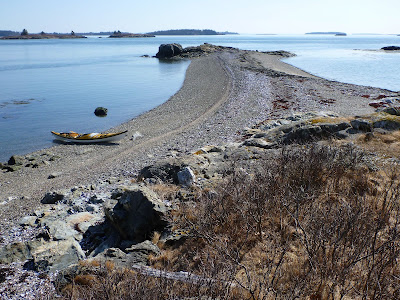 |
| Great Spruce Head Island, Colt Head in the background |
The seas looked calm on Monday- only 5-knot winds in the forecast, and warm air- above fifty even. Calm comes in varying degrees. There's "flat-ass calm," which is mirror-like, glassy. Wait, maybe that's "glassy-calm" or "calm as glass." Either way, on the calm scale, the seas were a notch or two above that, but were nonetheless the sort of calm seas upon which you could paddle across Penobscot Bay.
 |
| Seals, west side of Great Spruce Head Island |
I didn't have that thought until I took a break on a small cobble beach on the west side of Great Spruce Head Island. I'd launched from Sylvester Cove a couple of hours earlier and paddled out past Hardhead and along the southern shore of Butter Island before crossing over through the Barred Islands to Great Spruce Head. But there I was, half-way across the bay, looking over toward the southern end of Islesboro and the Camden Hills beyond- all looking fairly close. As cool as such an undertaking would be, I didn't have it in me to paddle thirty miles and get home late. I like meandering too much.
 |
| Southern Point, Great Spruce Head Island |
Great Spruce Head Island was the summer home of photographer Eliot Porter and his brother, the painter Fairfield Porter, so for me, paddling past their haunts has the feel of a pilgrimage. Their island scenes are easily recognizable, even if the trees have grown-in over the past... I was going to write "fifty years," but the Porters spent their first summer on the island in 1912- a century ago. In his book Summer Island: Penobscot Country, Eliot Porter tells the story of how the island became a part of their lives. Through his photographs and stories, Porter describes getting to know his island and the people in the area, as well as excursions to other parts of Penobscot Bay. He found Stonington to be "the most engaging today, and in many ways the most attractive..." of Penobscot Bay towns. That's good to hear, but as I read his book, I felt envious of his family's island. Fortunately, the family generously allows the public to land on what signs designate as a "privately-held nature preserve".
 |
| The view from Montserrat Hill, Butter Island, looking toward Eagle Island |
Tom Cabot bought Butter Island back in the 1940s, and like so many of the islands that he bought and gave to land trusts or to the state, he shared it with the public. By the 1990s, during summer months the island often received over 150 visitors a day, and this use took its toll. And it made it tough to carve-out any private space when the family built a house on the northernmost hilltop. Caretakers had to call authorities to eject boatloads of campers who camped anywhere and cut-down trees to fuel their bonfires. At one point, Tom Cabot found a squatter living in a makeshift home built in a spruce thicket (something I would have done in my twenties... actually, something I did, but that's another story).
So now there's a designated public area on the east side of the Island. You can land on Orchard or Nubble Beach and hike up to the top of 150-foot Montserrat Hill, where a granite bench memorializes Thomas and Virginia Cabot. The view is probably akin to what may have been seen from many of these islands a hundred years ago, back when the trees were cut for fuel or lumber and sheep and livestock kept the grasses munched-down. For me, it was a view of my paddle home, out past Hardhead on calm seas back to Deer Isle.



No comments:
Post a Comment